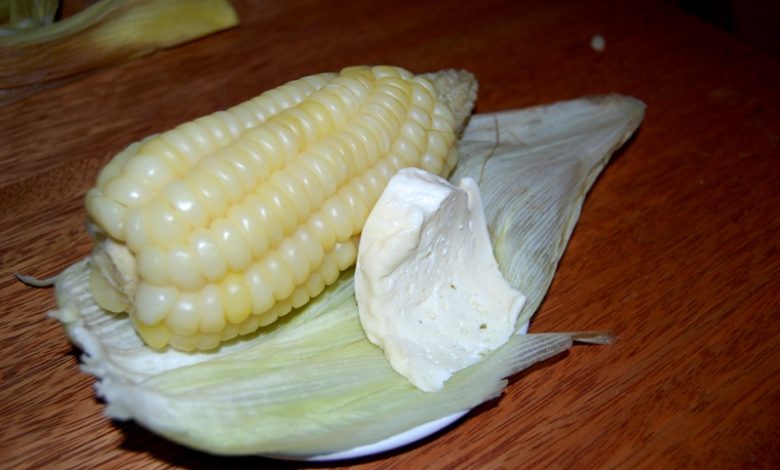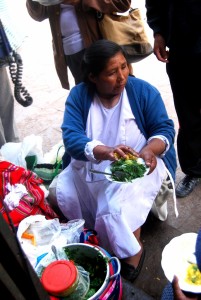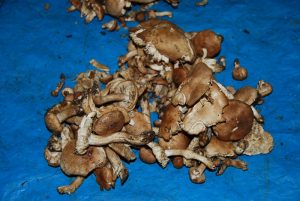Shouts up Doorways, White Hats on Streets, and Cuzco’s Seasonal Food

The voice ripped up the stairway from the plaza, as if tearing a cloth of difference. I was sitting in the second floor of a coffee house just off Cuzco’s Plaza de Armas, Main Square, where they specialize in crepes and coffee. At first the voice seemed strange, and then I could pick out the words, “choclo con queso”, “corn on the cob and cheese”.
Ordinary, traditional Cuzco broke through the barrier of Lizst playing on the speakers and the scent of fresh brewed coffee floating up from below, along with the comfort of overstuffed, leather chairs.
The time of fresh corn is coming soon, people say. In the lower, irrigated valleys nearby the corn has been growing for a while and it is like July 4th in the United States when stand pop up everywhere to offer this delicacy that could not be more American, North and South. Here, the New Year is coming, a time of heavy rains, mudslides, and lots of ears of corn. They will just get more and more common until they start diminishing sometime in April.
But they do not show up much in the tourist restaurants where food is like living in a Kroger cooler. The same things are always available year round whether in season or out. Though Plaza Vea, Orion, and Mega have already brought the Joy of Supermarkets to Cuzco, nonetheless, the city is still tied to the rhythms of its hinterlands and their fields.

The land is wet. It rains every day or night, sometimes for hours, though eventually the sun and moon seem to always break through as if playing a cameo in someone else’s movie. The moisture is causing food to grow, seemingly everywhere.

It is not just sweet corn that is appearing. Yesterday morning, as I was returning home, a woman in a stove pipe white hat and broad, pleated skirts, the sign of a traditional cholita, a woman of the towns and city, a market woman in traditional Cuzco, knelt by the open door of the neighbor’s house and was dishing up a dish of fresh mustard greens.
Here they call them nabo, which in English generally means “turnip” though I swear they are wild mustard.
These greens spring up all over the place, wild and untamed. They are bright green, seemingly greener than anything else. Even emeralds look murky before them. And their perky little yellow flowers as they start to bloom make an amazing contrast, bursts of sun in a verdant landscape.
The Mamacha, as she is called here, or “dear, little lady (mother)” had dished a mound of that green onto a plate and contrasted it with the lighter yellow of fresh boiled potatoes and was handing it to the neighbor woman, standing in her open doorway.
The green of this dish, called Yuyo Jaucha, was sharper and stronger than the grass strip between sidewalk and street. It was more than gemlike, and looked enticing.
In the markets, little wet balls are starting to appear. They are an edible bacteria gathered in ponds and streams in the highlands. Called Llullucha, they make their way into many seasonal dishes.
It is a sexual time of year. Reproduction is rife, from dogs copulating on the corner, to the riot of flowers and insect, stamens and pollen all at the ready.
Lightning often zags across the sky and sometimes crashes to land. People say that where it crashes and plunges into the earth, wild mushrooms, called kallampa (or callampa) in Quechua, will spring up the next day.

These mushrooms are starting to make their way to market. Soon plates of mushrooms and cubes of fresh cheese in a creamy sauce, served with potatoes will also spring up. Called Kapchi de cetas, or mushroom kapchi, this mixture of soft, farmer’s cheese and wild mushrooms tastes of the muskiness and woodiness of wild fungi, balanced by the creaminess of cheese that is only a few days old.
It is one of the most typical of Cuzco’s dishes, without doubt. Unless you are willing to go to the market, eat on the street, or pay attention to the unrestrained and passionate shouts up stairways, you will have a hard time finding it in the restaurants of tourist Cuzco.
Nevertheless, in evenings, as the sun sets, and sometimes as rain splashes nearby, you will see lines of people sitting or standing under the arches that front the plaza. Nearby is a mamacha, sometimes with the iconic white, stovepipe hat, and generally without. But she will always be near large tin pans wrapped in white cloth, and she will be serving up fresh food for the people, locals, who work on the plaza and in its restaurants.
The restaurant workers often do not eat what they produce and sell. Instead they depend on mamachas to bring them food that for them is more aesthetically pleasing (and more economical, of course). They gather and chow down on local food that changes with the seasons.
I was just telling someone from here about the shout up the stairs. “Is there choclo con queso already. I love choclo con queso. I have to get myself some.”
For those who are not from Cuzco, this is not the cloyingly sweet corn of North America with its tender kernels, instead it is a starchy yet delicious corn, less sugary than corny. You eat its kernels one by one from the cob, tearing them off with your fingers. Sometimes you even peel them, while occasionally taking a bit of cheese.
This is Cuzco these days,




